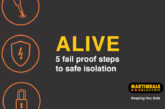
Most electricians might assume that the use of fuse-protected leads is unnecessary when carrying out ‘dead’ testing on circuits proven to be de-energised by a recognised safe isolation procedure. Equally, many might think that such leads are always required when testing energised circuits or equipment. This article from the experts at NICEIC discusses the issues that will influence the decision as to whether or not fused leads need to be employed when using electrical test instruments.
The general safety requirements for electrical test instruments are given in the BS EN IEC 61010 series of standards (Safety requirements for electrical equipment for measurement, control, and laboratory use), with the specific requirements for hand-held and hand-manipulated probe assemblies for electrical test and measurement covered by BS EN IEC 61010-031. Conformity with the relevant parts of this multi-part standard satisfies the product certification requirements of the Low Voltage Directive and the corresponding UK Electrical Equipment (Safety) Regulations 2016.
More specific requirements for electrical test instruments are given in the relevant parts of the BS EN 61557 and BS EN IEC 61557 series (Electrical safety in low voltage distribution systems up to 1,000 VAC and 1,500 VDC— Equipment for testing, measuring or monitoring of protective measures). Neither of these series of standards specifically requires the use of fused test leads for a particular application.

Testing instruments and leads
If an instrument for testing continuity, insulation resistance, loop impedance, earth electrode resistance or any combination of these conforms to BS EN IEC 61010 or BS EN 61557 / BS EN IEC 61557, it should not be necessary to use fused leads since safety is intrinsic within the design of the instrument when used in conjunction with the leads supplied with the instrument.
It should be noted, however, that such instruments do not protect against faults occurring between a single test lead and earth when the test probe is connected to an energised circuit, for example if a test lead were to be trapped in an electrical cabinet door.
In the case of those tests that are intended to be carried out with the installation de-energised, there should be no risk of electric shock if the circuit or equipment under test has been isolated using an appropriate safe isolation procedure¹.
The Health and Safety Executive publication Electrical test equipment for use on low voltage electrical systems (GS38) gives guidance on the safety requirements for the design of test probes and leads for use with test instruments, test lamps and indicators used to detect the presence (or absence) of voltage. Although not specifically intended, this guidance is often applied to leads used with other test instruments.
While the leads provided with a test instrument meeting the requirements of the relevant parts of BS EN IEC 610101 or BS EN 61557 / BS EN IEC 61557 should be adequate for the intended use of the instrument, this might not be the case for an instrument that does not conform to those standards. In such cases, the use of fused leads is recommended.
In the case of a multimeter, an incorrect range setting could be selected inadvertently, allowing an excessive current to pass through the instrument and leads. It is for this reason that GS38 recommends (in paragraph 21) that fused leads should be used with such test instruments.
It should be noted, however, that merely using fused leads with an otherwise unsuitable test instrument will not necessarily make it safe to use.
In the case of a test to establish the presence or absence of voltage, the use of a proprietary test lamp or 2-pole voltage detector suitable for the working voltage is preferred (paragraph 19 of GS38 refers).
It is essential that the leads for use with any type of test instrument that are intended to be applied to live terminals at low voltage are inspected prior to each use to confirm that they remain in a satisfactory condition.
Regardless of whether fused or unfused leads are used, the length of exposed tip on the test probes should be kept as short as possible to minimise the possibility of arcing, flashover or electric shock occurring.
GS38 recommends that probes are insulated to leave no more than 4 mm and, where practicable, only 2 mm or less of exposed tip. Alternatively spring-loaded, retracting shields may be used (paragraph 9 refers).
Where there is any doubt as to whether the presence of fuses and/or resistances in fused lead sets will adversely affect the functionality or safety of the test instrument the advice of the manufacturer should be sought.
Further information about the selection of test probes, leads, test lamps and voltage indicating devices can be found in GS38, which may be downloaded free of charge from: www.hse.gov.uk/pubns/books/gs38.htm
Summary
Where a multi-functional test instrument is used for verification, conforming to BS EN IEC 61010 or BS EN 61557 / BS EN IEC 61557, it is not usually necessary to use fused leads since safety is intrinsic within the design of the instrument and when used with the test leads supplied with the instrument.
However, such instruments do not provide protection against faults occurring between a single test lead and earth when testing an energised circuit.
Where a testing instrument does not conform to those standards the use of fused leads is recommended. Testing probes should be insulated such that no more than 4 mm, and where practicable, only 2 mm or less of exposed tip is shown.
Get more details about NICEIC registration here
Read more industry technical articles here








